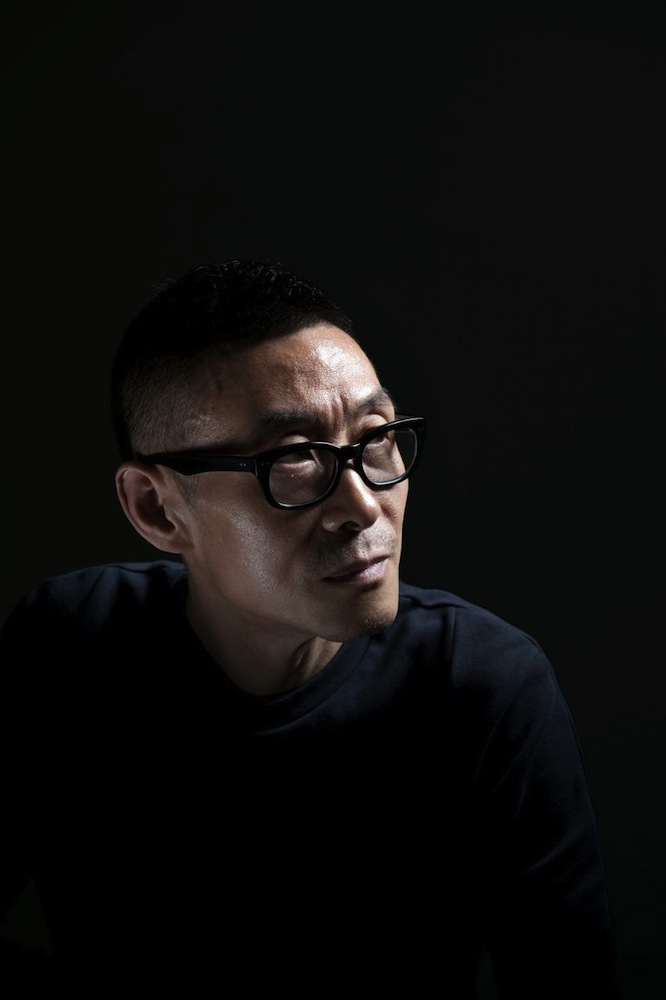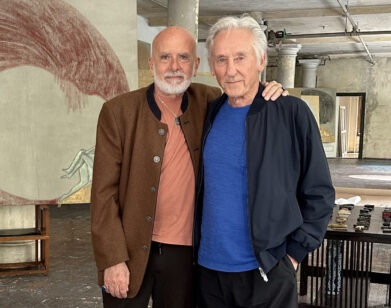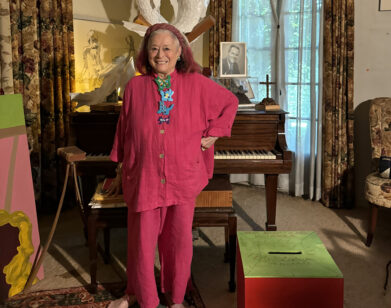Wang Jianwei in Process
Wang Jianwei contends that there’s more to art than what meets the eye. Rather than simply viewing abstract brush strokes on a gallery wall amidst a chorus of perfunctory “oohs” and “ahhs,” the Chinese contemporary artist believes art should be as multisensory as life itself: it should be seen, heard, tasted, smelt, and felt, through film, theater, sculpture, and installation. “Contemporary art includes the emancipatory manifesto that frees us from the romantic notion of ‘seeing is believing,'” explains Wang. “We often interpret a certain part of our experiences as the entirety, which prevents us from understanding the world correctly,” he continues. “Seeing is never purely an action of the eyes. Seeing itself includes a cognitive process and a certain way of understanding.”
Asian art expert Jonathan Napack once said, “Unlike Fang Lijun, who embraces the commercialism of the “new China” or Ai Weiwei, who reluctantly accepts a role as the path-breaker for the next generation, Wang Jianwei has remained individualist, solitary and cerebral.” Wang lives by the motto “my greatest enemy is certainty.” He presents the world as he sees it: black, white, and grey.
On Friday, Wang’s new exhibition “Wang Jianwei: Time Temple,” opened at the Guggenheim Museum in New York. It is the first in a series of three shows commissioned by The Robert H. N. Ho Family Foundation Chinese Art Initiative.
EMILY WASIK: You once said, “When I was studying art, Chairman Mao said that art should help people. This is one side of the coin. The other side is that art has to reflect society.” Why do you believe art should accomplish these two things and do you believe your art achieves both?
WANG JIANWEI: On the contrary, I hope my art is not situated within this coin at all. In fact, this is the specter of “realism” that is still haunting Chinese contemporary art—that art is only an instrument, an instrument to reflect society, that it must be useful for society. Also, I have noticed many Western media outlets are very insistent on understanding contemporary art in China through this kind of realist approach. Sometimes I even sense that they are intent on, as we say in China, “picking bones of politics out of an egg of art.” Or perhaps they see art as merely an instrument to reflect society.
WASIK: In 1975, towards the end of the Cultural Revolution, your education was interrupted when you were sent out to the countryside. How did your experiences during this Cultural Revolution era—your isolated time in the countryside, your six years in the military, and your job working in a factory—shape you personally and influence your art?
WANG: From about age 17 to 25, a time some people describe as “beautiful youth,” it was “arranged” for me to live with two different collectives. These eight years where I had absolutely no choice influenced me in two ways: firstly, I gained an understanding of “freedom.” To this day, I very much respect and treasure individual choice. Secondly, I developed a suspicion towards any kind of organization, collective, movement or uniform action, as well as a rejection of any kind of power.
WASIK: You’ve said in the past that your early education was kind of colonial, because your teachers knew only the Russian style. Then, in the ’80s, there was this sudden influx of Western culture. How did this burst of western influence initially affect you both personally and artistically?
WANG: It made me truly understand the meaning of “openness.” When you are a part of a world that is within an enclosed system, the biggest threat is that the loss of contact with any voice from the outside—a point of reference that is different from you—becomes habitual. The loss of this reference makes the enclosed system seem perfect. I can still feel this kind of threat today, the voice that gives legitimacy to various kinds of enclosure.
WASIK: Western audiences are often too eager to assume your works are simply a critique of the Chinese government, or even of Chinese society. In your opinion, where does your art stand?
WANG: Well, the subject of contemporary art should in fact include a political dimension, the distrust contemporary art has towards the existing order. One manifestation of this distrust is the very mechanical dichotomization between art’s form and its political content; the other is the institutionalizing tendency of anti-institutionalization. What I see is that we almost never resist ourselves—the part of ourselves that has been institutionalized, which includes resisting our habitual stance of resistance. Nor do we resist our existing knowledge, technology, and routine-ized slogans. We have occupied the word “resistance” and have become its owner, while “resistance” has become our servant. Thus, we own “resistance” and occupy it as a position of power. This attitude—perhaps attitude alone—dominates contemporary art, gradually evolving into a phonological methodology of naming enemies. We can no longer contemplate the subject—self—of contemporary art; it has been woven into infinite relationships, replaced by social movements, national image, and financial capital. The disappearance of the construction of the self of contemporary art makes it impossible to exist in the form of a subject. The subject of contemporary art that I speak of is a kind of naming event predicated upon the multiplicity of the environment. It includes politics, should have its own way of thinking, and can be perceived.
WASIK: A common criticism of your work by both the public and the media is that it is too complicated—that you are deliberately “mystifying” simple ideas. Why do you think your art is difficult to understand for some people?
WANG: First of all, I question whether the “public” represented by the media are real or only one variety of ideological hostages. The only legitimate interpretation of the concept of the “public” is that it’s a highly heterogeneous group of people, and I cannot imagine who has the right to speak on their behalf using a “public” voice. If the multiplicity of the environment is its true nature, then my works defend this truthfulness. The greatest fairness in society is to defend the difference between each individual—the fairness and truthfulness of their inconsistency and differentiation. Or do we believe there’s a standard procedure of “simplicity” and “complication?” In that case, any verdicts of “simple” or “complicated” act to deprive the basic rights of the labeled party. To a large extent, because we sense uncertain threats, we prefer to understand the complexity to any matter using a clear, generalizing approach, and then call them “complicated” when they refuse this kind of simple, brutal approach.
WASIK: You’ve also said that despite the belief by some that you are going very deep into the theory of art, you are actually just presenting the world as you see it. How so?
WANG: Opportunism towards knowledge is a utilitarian demand that knowledge must be immediately practical. Just like with sociology where we hope its purpose is to serve society, however, the true purpose of sociology lies in its impracticality. It cannot become practical or else it loses its meaning. Perhaps we should learn a different kind of knowledge: the knowledge to question knowledge. I think my original words were actually, “What I say cannot be used to interpret my work.” I have emphasized the difference between the artist’s words and the way of the artist’s work. They can’t supply practical information for each other. For example, I have emphasized the universality of art in my articles, but that doesn’t mean it becomes an instruction manual for my work.
WASIK: You graduated in oil painting from the Zhejiang Academy of Fine Arts in Hangzhou in 1987, went on to become a prominent painter, and then abandoned the medium in 1991. Why did you decide to put down the paintbrush and expand your artistic process to include documentary-style video, theater, performance, sculpture and installations?
WANG: There is a possibility that I will become a painter again, but not the kind of painter who uses only one medium to exhibit his work. When I look back on the past two decades of my journey today, I guess many people would interpret my artistic practice as a kind of cross-media attempt. I have indeed tried many different kinds of media over the past 20 years and collaborated in many different ways with people from many different fields. However, I like to understand this process as a kind of compensation for having once lost my “right of choice,” an exercise of free choice and taking responsibility for any consequences that might result from it. To be honest, it’s a bit of a paranoid act.
WASIK: You are especially attracted to the barely noticed gaps in our reality. Why the focus on the in-between? Why is it so fascinating to you?
WANG: We are still perceiving uncertainty as a kind of spatial concept—an inbetweenness regarding locations, venues, and connectivity. We are not comprehending it in terms of time—the possibility brought about by time processes and events. If you think about it, uncertainty is perhaps the norm when we are confronted with this world.
WASIK: Process has been integral to your work from the outset. Why are you more focused on the evolving route of the artist’s journey, rather than interpreting each work as finished piece?
WANG: This has a lot to do with my worldview. I believe the only universality that exists in this world is its instability because everything is always in process. Things in process are unrepeatable and how can the things that are unrepeatable be understood? Can we even depict the instability of a thing? It is not the record of a process, nor the compounded explanation based on this record, rather it is precisely this process that creates its own forms. This work related to time can be understood as a kind of rehearsal. Rehearsal is not a method. It must always keep things in a state of infinite openness. Rehearsal is also not what we generally understand it to be—waiting for a kind of occasional, random surprise. Essentially, rehearsal is sustained actions towards the possibilities in progress. In this process, things are in a state of a constant flux of randomness and inevitability. In the process of infinite labor and timeless actions, the process takes on a certain form—a form of time—and transforms into visibility. Therefore, the form of time is a kind of thoughts production. It does not need interpretations of knowledge with other content to become itself.
WASIK: Your exhibition title “Time Temple” alludes to one of your central concerns—the question of how one thinks of and experiences time. How will you approach the concept of time in the exhibition, and how do you personally perceive and experience time?
WANG: “Time Temple” is about time and things situated in time. First and foremost, its focus is on the imagination of a thing that has not arrived, and on the potentiality of time or a time of potentiality. A thing, in a given time, possesses two or more capacities or possibilities that coexist in an interdependent manner. Alternatively, we could also say that any one thing or event in time is always related to an open-ended choice. They simultaneously retain the whole of yes and no—regardless of whether there is actually an agreement between the two—and contradiction, a time that contains the double imagination of randomness and inevitability.
WASIK: I heard you were inspired by Franz Kafka’s novella The Metamorphosis for the film you will present at “Time Temple,” what other influences throughout time have inspired you the most?
WANG: The Morning Time Disappeared, the film that is an integral part of the “Time Temple” exhibition, continues my work from a few years ago that explored new possibilities between image and painting. The question is whether a superficial image exists. Just like what Barnabas said in The Castle, another novel of Kafka’s, “Perhaps he is only a messenger, he does not know the content of the letter that was entrusted to him.” Perhaps the “superficial image” is a messenger who does not know the content of the image? Can an image only be used as a kind of interpretive tool? For my live performance at the opening of the exhibition, I have chosen 10 key words. One of them is “Gnosticism.” I chose it because of its relation to the resurrection of time. For the Gnostics, the resurrection does not take place in the future; it has already taken place. It is a concept of “abruptly interrupted” time—a contemporaneous time.
As for what other influences that have inspired me, in China, there is a proverb that goes, “Traveling among any three, I will surely find one as my teacher.” Surely there will be an unimaginable number within an unimaginable number of people and things that will influence and inspire me in the years to come.
“WANG JIANWEI’S: TIME TEMPLE” IS ON DISPLAY AT THE GUGGENHEIM MUSEUM THROUGH FEBRUARY 15, 2015. FOR MORE DETAILS, VISIT THE MUSEUM’S WEBSITE.







